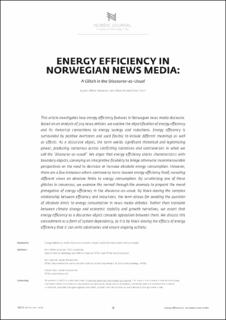| dc.contributor.author | Johansen, Jens Petter Kirkhus | |
| dc.contributor.author | Røyrvik, Jens Olgard Dalseth | |
| dc.contributor.author | Fyhn, Håkon | |
| dc.date.accessioned | 2023-01-20T12:30:38Z | |
| dc.date.available | 2023-01-20T12:30:38Z | |
| dc.date.created | 2021-03-17T16:18:36Z | |
| dc.date.issued | 2020 | |
| dc.identifier.citation | Nordic Journal of Science and Technology Studies. 2020, 8 (2), 18-32. | en_US |
| dc.identifier.issn | 1894-4647 | |
| dc.identifier.uri | https://hdl.handle.net/11250/3044946 | |
| dc.description.abstract | This article investigates how energy efficiency features in Norwegian news media discourse. Based on an analysis of 309 news articles, we explore the objectification of energy efficiency and its rhetorical connections to energy savings and reductions. Energy efficiency is surrounded by positive overtones and used flexibly to include different meanings as well as effects. As a discursive object, the term wields significant rhetorical and legitimizing power, producing consensus across conflicting narratives and controversies in what we call the “discourse-as-usual”. We argue that energy efficiency shares characteristics with boundary objects, conveying an interpretive flexibility to bridge otherwise incommensurable perspectives on the need to decrease or increase absolute energy consumption. However, there are a few instances where controversy turns toward energy efficiency itself, revealing different views on absolute limits to energy consumption. By scrutinizing one of these glitches in consensus, we examine the normal through the anomaly to pinpoint the moral prerogative of energy efficiency in the discourse-as-usual. By black-boxing the complex relationship between efficiency and reductions, the term allows for avoiding the question of absolute limits to energy consumption in news media debates. Rather than translate between climate change and economic stability and growth narratives, we assert that energy efficiency as a discursive object conceals opposition between them. We discuss this concealment as a form of system dependency, as it is by black-boxing the effects of energy efficiency that it can unite adversaries and ensure ongoing activity. | |
| dc.description.abstract | Energy efficiency in Norwegian news media — A glitch in the discourse-as-usual | |
| dc.language.iso | eng | en_US |
| dc.rights | Navngivelse 4.0 Internasjonal | * |
| dc.rights.uri | http://creativecommons.org/licenses/by/4.0/deed.no | * |
| dc.title | Energy efficiency in Norwegian news media — A glitch in the discourse-as-usual | en_US |
| dc.title.alternative | Energy efficiency in Norwegian news media — A glitch in the discourse-as-usual | en_US |
| dc.type | Peer reviewed | en_US |
| dc.type | Journal article | en_US |
| dc.description.version | publishedVersion | |
| dc.source.pagenumber | 18-32 | en_US |
| dc.source.volume | 8 | en_US |
| dc.source.journal | Nordic Journal of Science and Technology Studies | en_US |
| dc.source.issue | 2 | en_US |
| dc.identifier.doi | 10.5324/njsts.v8i2.3393 | |
| dc.identifier.cristin | 1898792 | |
| dc.relation.project | Norges forskningsråd: 257632 | |
| cristin.ispublished | true | |
| cristin.fulltext | original | |
| cristin.qualitycode | 1 | |

